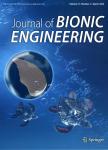Multi-material Bio-inspired Soft Octopus Robot for Underwater Synchronous Swimming
作者机构:Department of Mechatronics EngineeringJeju National UniversityJeju 63243South Korea Department of Electrical EngineeringSukkur IBA UniversityAirport RoadSukkur 65200SindhPakistan Advanced Micro Mechatronics and Energy LabSukkur IBA UniversitySukkur 65200Pakistan Department of Ocean SciencesJeju National UniversityJeju 63243South Korea
出 版 物:《Journal of Bionic Engineering》 (仿生工程学报(英文版))
年 卷 期:2022年第19卷第5期
页 面:1229-1241页
核心收录:
学科分类:080202[工学-机械电子工程] 08[工学] 0804[工学-仪器科学与技术] 0802[工学-机械工程]
基 金:This work was supported by the National Research Foundation of Korea(NRF)Grant funded by the Korea government(MSIT)(NRF-2022R1A2C2004771) Internal Research Grant by ORIC,SukkurIBA University 2022
主 题:Bio-inspired Octopus Octobot Sub-surface Soft robotics Swimming
摘 要:Inspired by the simple yet amazing morphology of the Octopus, we propose the design, fabrication, and characterization of multi-material bio-inspired soft Octopus robot (Octobot). 3D printed molds for tentacles and head were used. The tentacles of the Octobot were casted using Ecoflex-0030 while head was fabricated using relatively flexible material, i.e., OOMOO-25. The head is attached to the functionally responsive tentacles (each tentacle is of 79.12 mm length and 7 void space diameter), whereas Shape Memory Alloy (SMA) muscle wires of 0.5 mm thickness are used in Octobot tentacles for dual thrust generation and actuation of Octobot. The tentacles were separated in two groups and were synchronously actuated. Each tentacle of the developed Octobot contains a pair of SMA muscles (SMA-α and SMA-β). SMA-α muscles being the main actuator, was powered by 9 V, 350 mA power supply, whereas SMA-β was used to provide back thrust and thus helps to increase the actuation frequency. Simulation work of the proposed model was performed in the SolidWorks environment to verify the vertical velocity using the octopus tentacle actuation. The design morphology of Octobot was optimized using simulation and TRACKER software by analyzing the experimental data of angle, displacement, and velocity of real octopus. The as-developed Octobot can swim at variable frequencies (0.5–2 Hz) with the average speed of 25 mm/s (0.5 BLS). Therefore, the proposed soft Octopus robot showed an excellent capability of mimicking the gait pattern of its natural counterpart.



